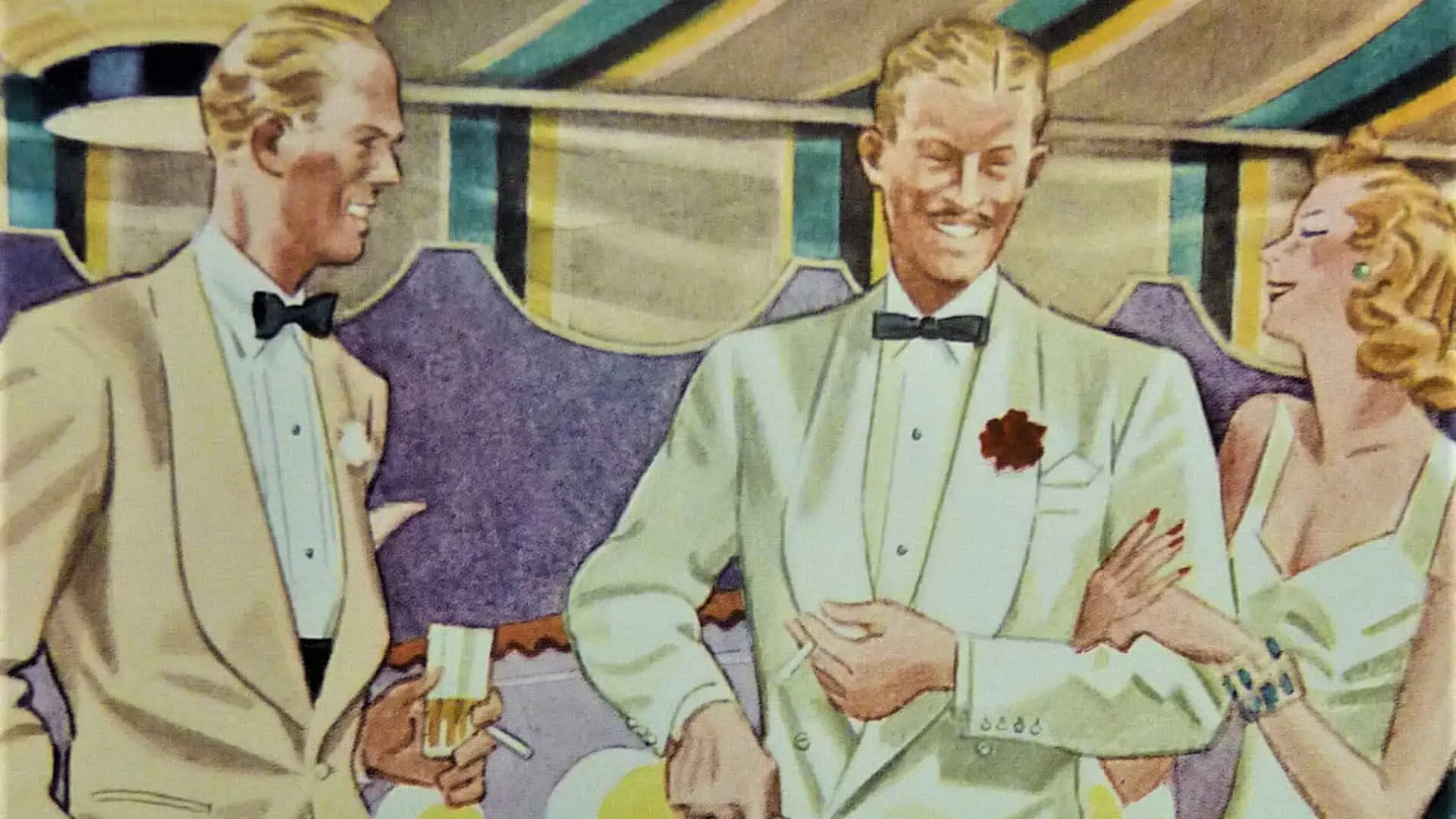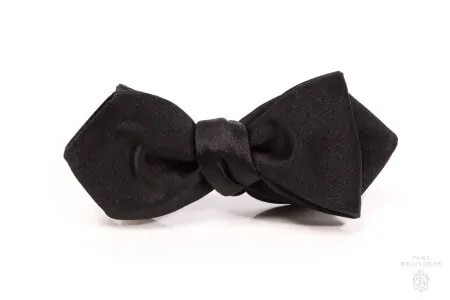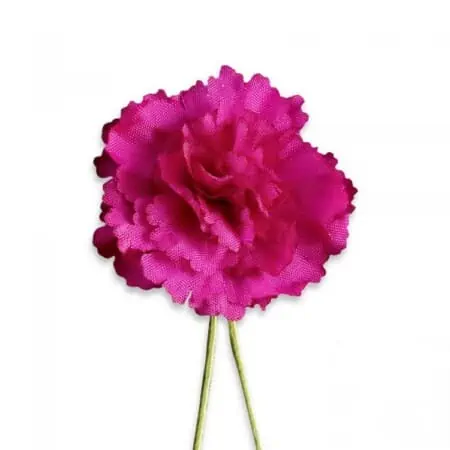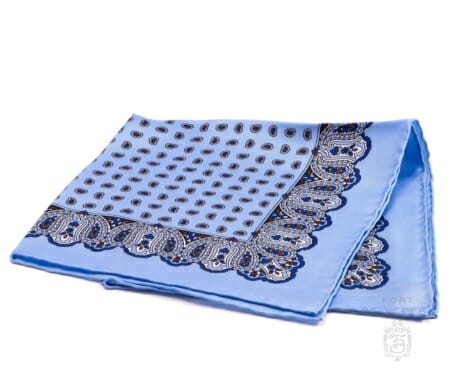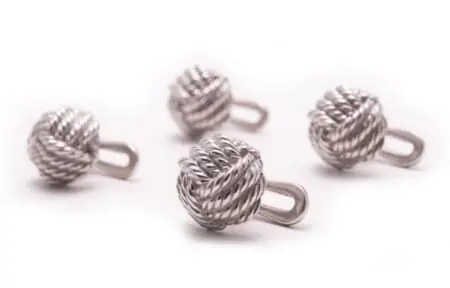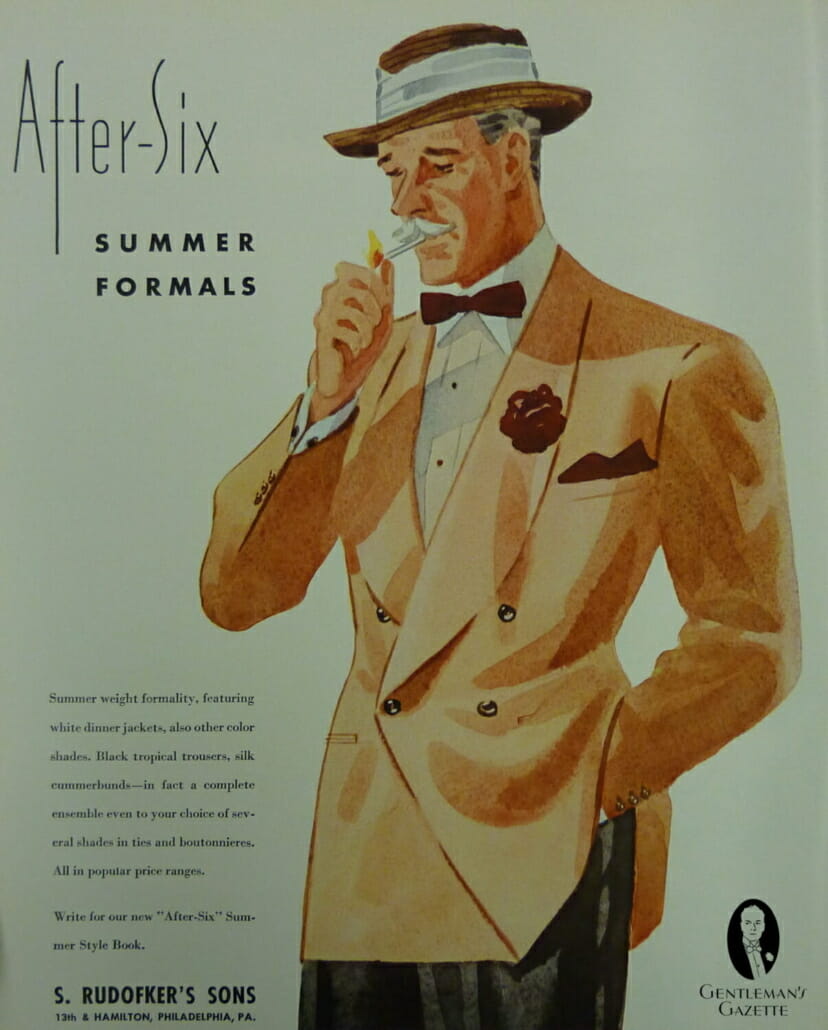
Gentlemen of style have been trying to keep cool, even when wearing Black Tie, throughout the ages. In this section, you’ll learn about how the conventions of Black Tie were adapted to meet the realities of formal festivities in warm weather.
- Early History of Warm-Weather Black Tie
- The Appearance of the Double Breasted Jacket and Soft Shirt
- The Mess Jacket Revolutionizes Warm-Weather Black Tie
- The White Dinner Jacket: A Perennial Favorite in Warm Weather
- Colored Jackets & Accessories: Vibrant Hues in Hot Climates
- Outerwear in Warm Weather
- Formal Facts
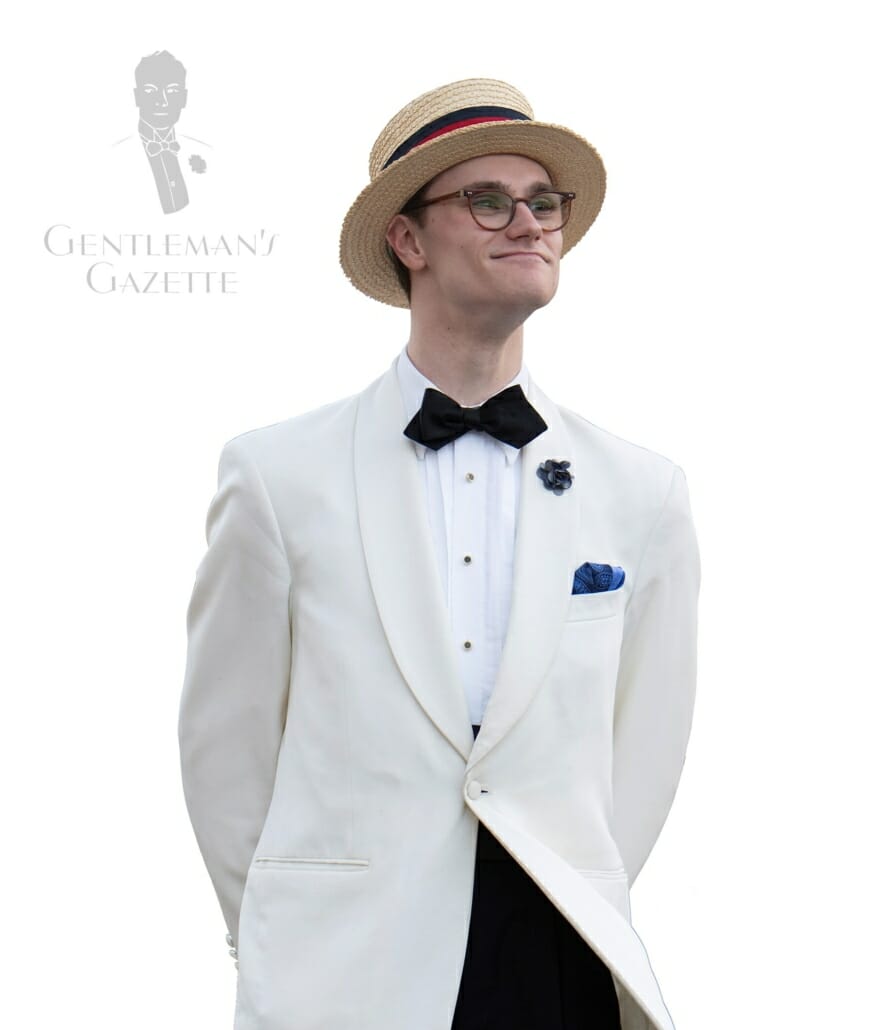
Early History of Warm-Weather Black Tie
“Evening dress is the proper attire, winter or summer, on all occasions after candlelight,” said American etiquette manual The Complete Bachelor in 1896. Pretty much the only allowance for hot weather was the substitution of the dinner jacket for the tailcoat, a practice that became progressively more common during the early years of the 20th century. (Little wonder considering that the tailcoat was expected to be worn with an overcoat year round.) There was also some experimentation with all-white dinner suits at the turn of the century but this was short lived.
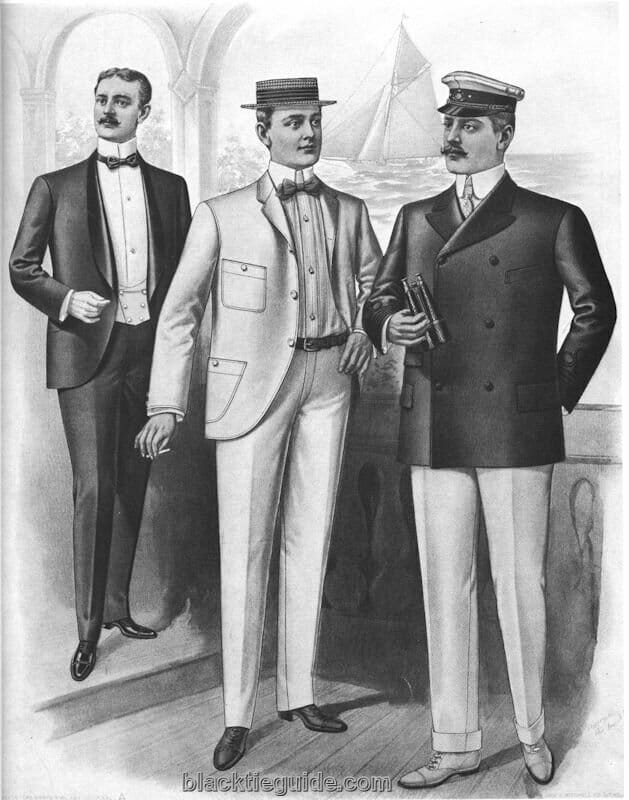
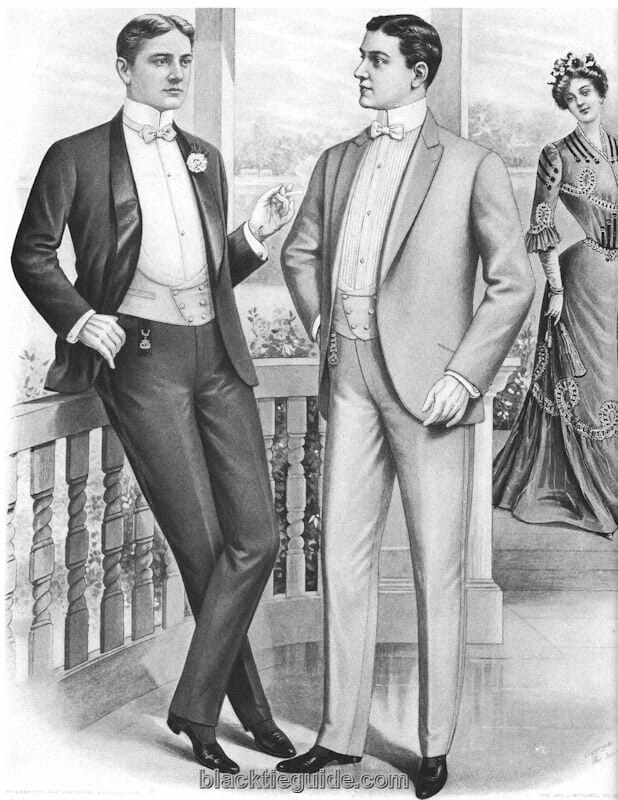
In the United States the requirement for warm-weather formal wear was not always followed. In particular, a common kit for Saturday night summer parties at country clubs in the 1920s was a blue jacket, white flannel trousers, white shirt, long tie and spectator shoes. The wearing of a dinner suit in hot weather was a practice largely limited to the eastern states according to a 1931 Men’s Wear article that encouraged retailers and tailors to promote its use nation wide. The trade magazine’s rationale was that although “in the winter-time the dinner jacket outfit is modified by the adjective ‘informal’ . . . during the summer months, it stands as both “formal” and informal.” Consequently, it was to be considered “the criterion of summer evening wear”.
While the tuxedo offered some practical benefits over the less formal alternative in that dress pumps were lighter than spectator shoes and bow ties more minimal than four-in-hand ties, it still didn’t compare with the comfort allowed women by their cool and colorful evening dresses. This may not have been much of an issue in the temperate UK but it certainly was during hot summers in the US which is likely why many of the warm-weather alternatives originated there.
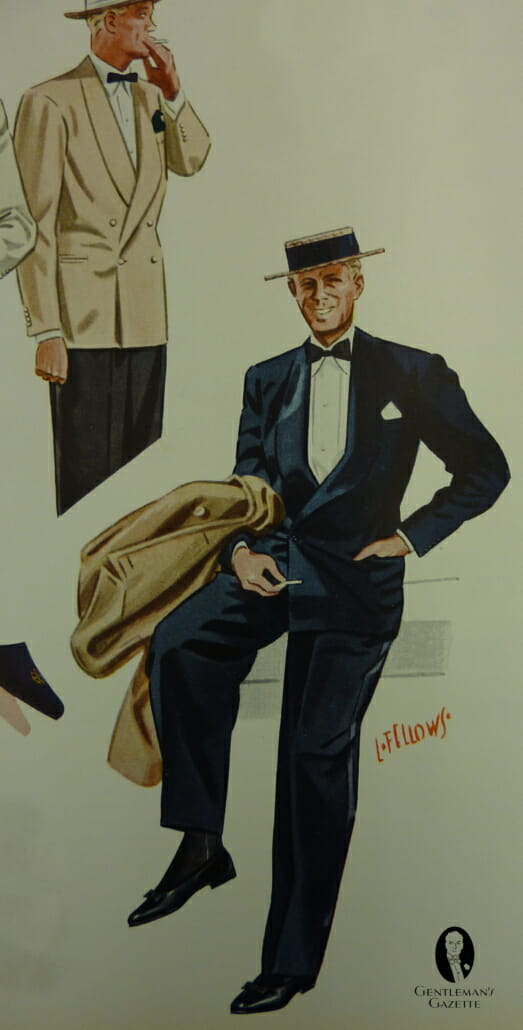
The Appearance of the Double Breasted Jacket and Soft Shirt
The concurrent appearance of the double-breasted dinner jacket and the soft, attached-collar shirt in the US in the 1920s was the first stab at more comfortable summer evening wear.
The jacket was not only constructed of lightweight material (as were the trousers) but also featured a narrow overlap of the fronts which allowed for a larger opening above the buttons and less layered material below them. Initially worn with a waistcoat and favored only by young trendsetters, by Christmas 1931 Apparel Arts was reporting that “The double-breasted dinner coat, because of its elimination of a vest, replacing it with the all-comfortable Cummerbund, has become a practical, permanent necessity in all southern wardrobes.” The waist covering was soon dispensed with altogether allowing the jacket’s practicality to win over its relative informality and making it popular for summer yachting or tropical winter resorts.
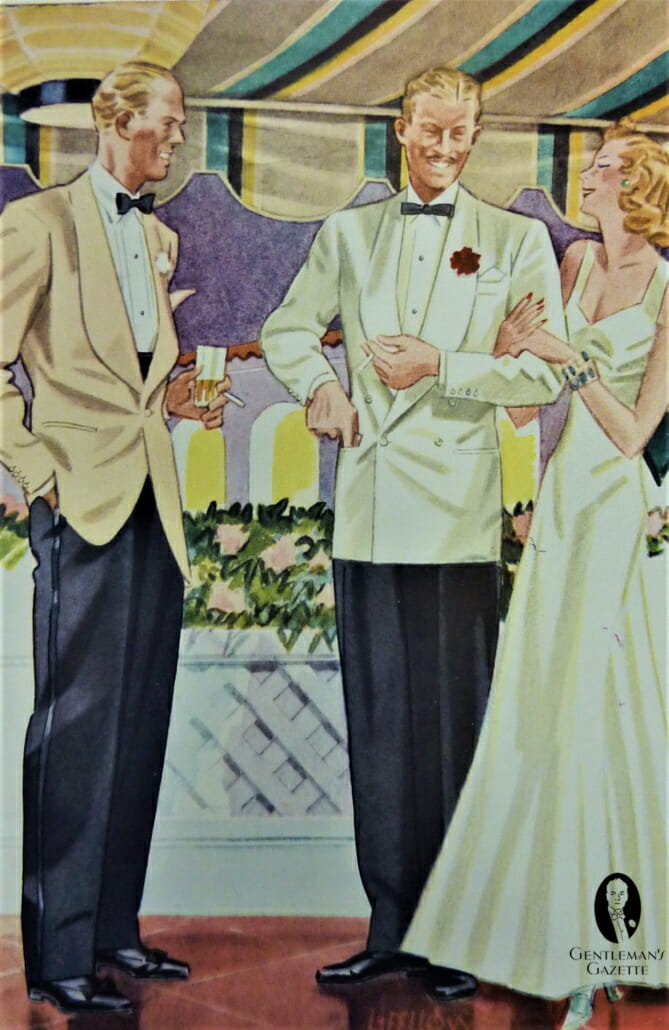
In 1935, Apparel Arts announced that smart socialites summering at exclusive Palm Beach and Rhode Island resorts had taken to the lightweight midnight-blue double-breasted dinner jacket with shiny black satin lapels, reflecting the vogue for dark blue evening wear in general.
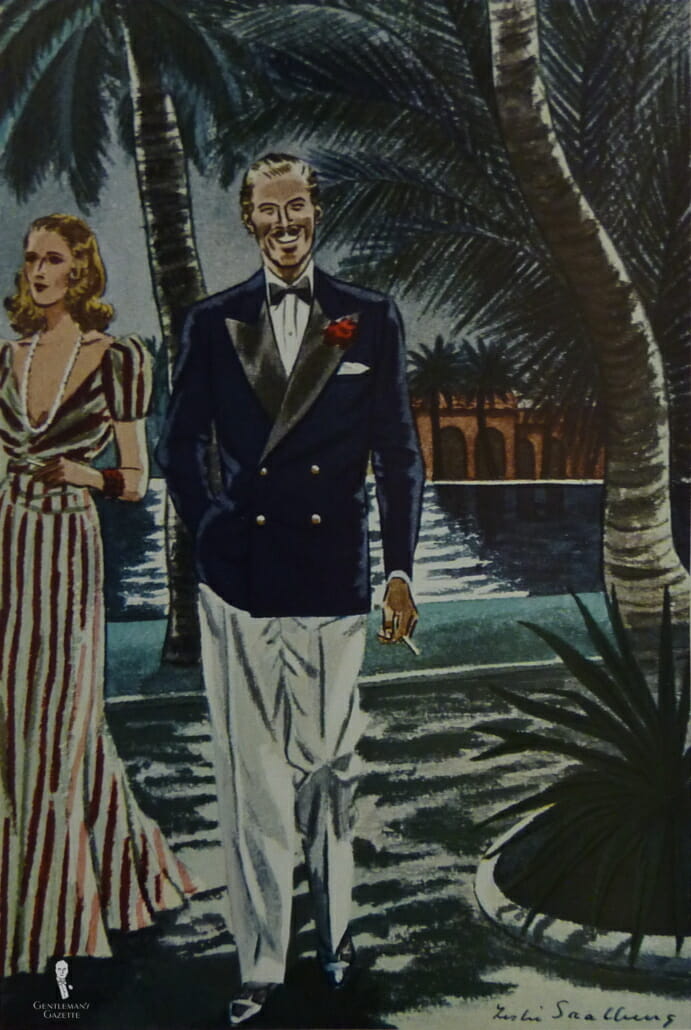
“With it is worn a semi-stiff pleated bosom dress shirt, white starched fold collar, black semi-butterfly dress tie, silk hose, and patent leather pumps.” The double-breasted model would remain popular until World War Two when fabric rations temporarily brought a halt to its construction. Although it returned to popularity after the war, it was no longer exclusive to warm-weather occasions.
The Mess Jacket Revolutionizes Warm-Weather Black Tie
In May of 1931 just as Men’s Wear was proclaiming the necessity of the double-breasted summer jacket it also provided what might be the first depiction of a much more radical summer kit:
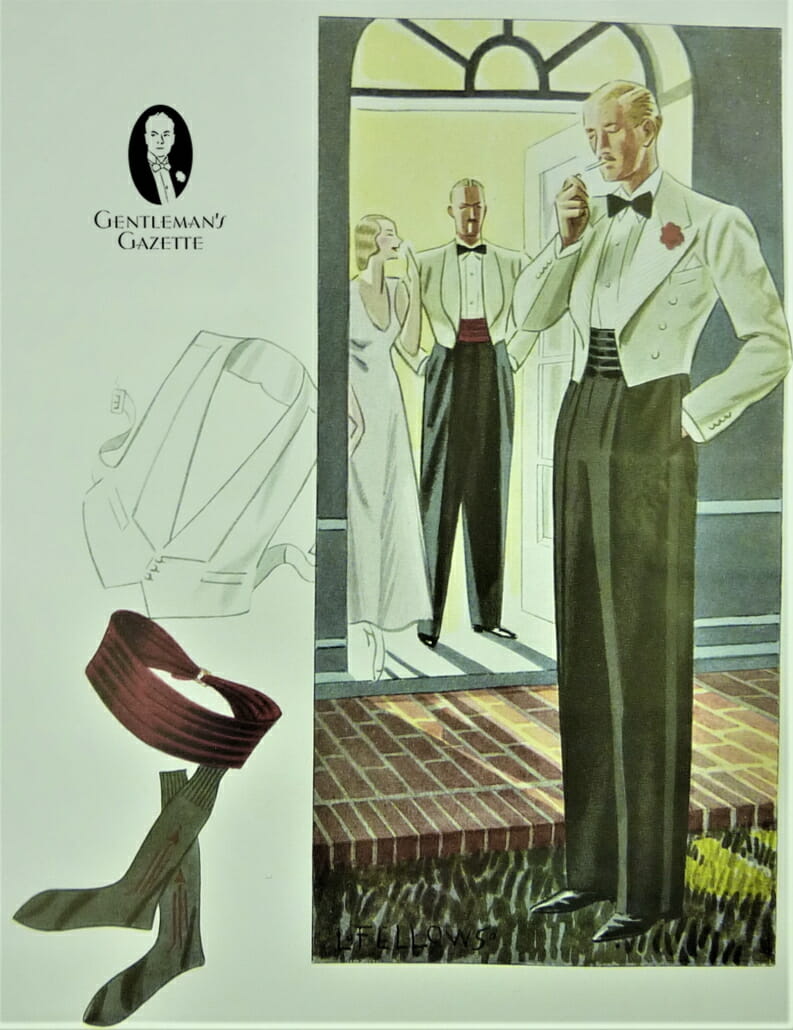
Evening dress, unprescribed, that may be used aboard ship on warm nights. The short jacket, on eton lines, and the waistcoat are made of white duck [canvas]. With this the regular evening shirt, collar, tie, black trousers and patent leather pumps are used, with modest studs and cuff links of enamel, perhaps centered with small pearls.
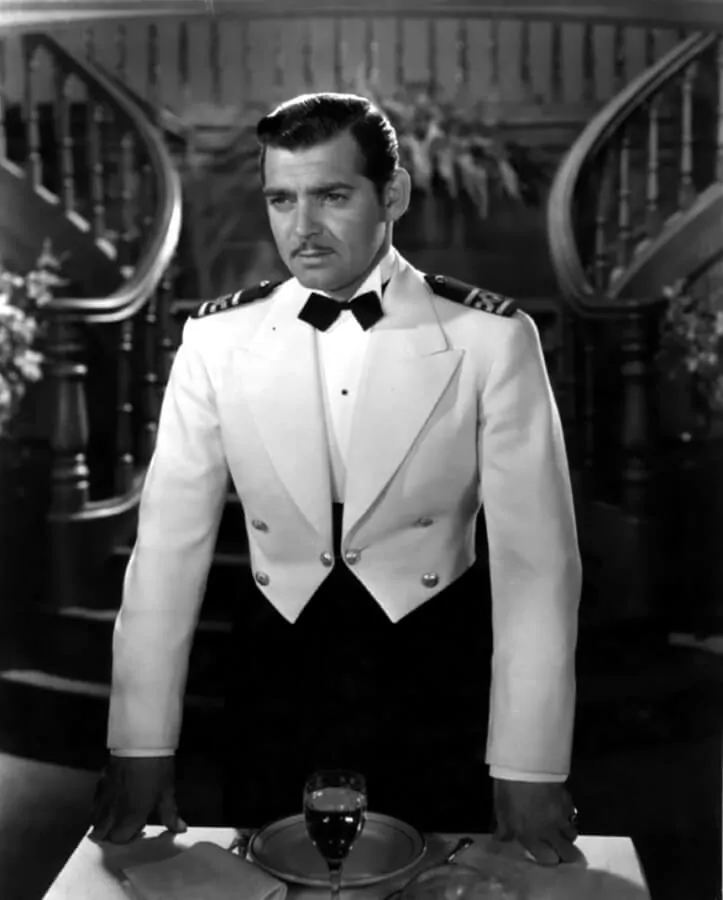
The eton reference was to a tail-less tailcoat worn by junior students at Eton college that had become popular dress-up clothes for boys around the world. Five months later the same magazine presented a variation of the new jacket as seen in Cannes but referred to it more appropriately as a “mess jacket”, reflecting the garment’s origins in tropical evening wear worn by British naval officers. The illustration showed that the French had taken warm-weather comfort a couple of steps further by ditching the waistcoat and replacing the stiff shirt with a softer turndown collar version. They also added their own fashion flair with a link button jacket front that kept the wearer’s waist covered and trousers of a matching white canvas.
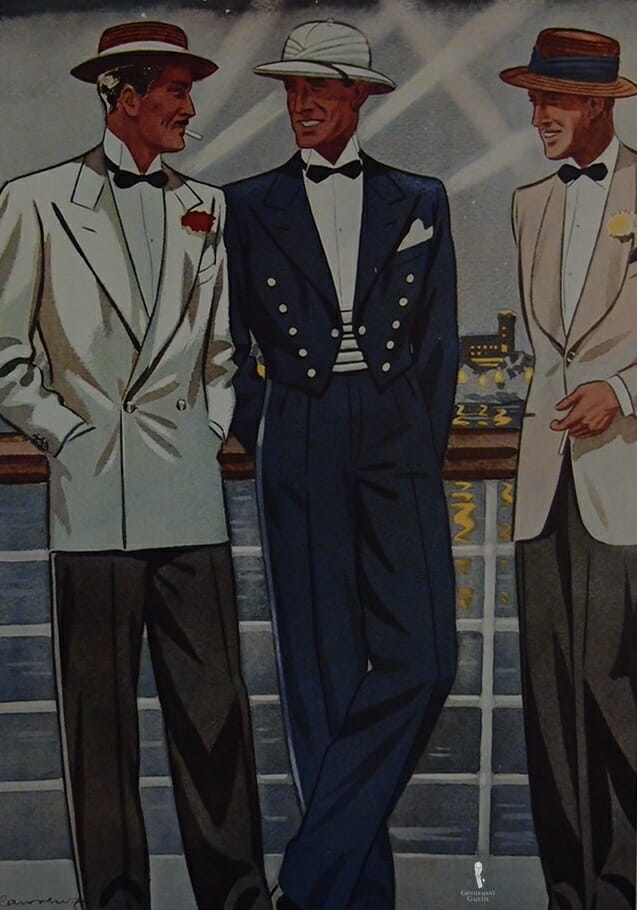
At the end of the year, Apparel Arts jumped on board with their own depiction of the mess jacket which was virtually identical to the first one seen in Men’s Wear. “By its adoption by well-dressed Americans for wear aboard their yachts and at smart Palm Beach evening functions,” said the magazine, “it is accepted as being correct.” The jacket was constructed of either gabardine, duck, or a washable material such as linen with a waistcoat of the same fabric. Trousers were high-waisted black or midnight-blue formal trousers with no back pockets due to the fact that the seat was completely exposed by the short jacket. They were often tropical weight making them lighter and therefore cooler than regular dress trousers. Other accoutrements were the same as for the tuxedo: the shirt was a stiff-front wing collar, the bow tie was black silk, and shoes were black patent-leather pumps or oxfords.
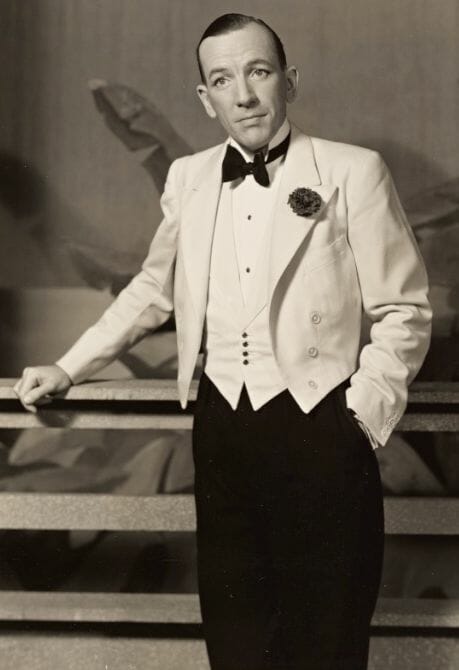
The look was an immediate hit in the US and by 1933 a new more “informal” jacket model had appeared, sporting a shawl collar without the buttons or breast pocket featured on the peaked lapel version. The outfit’s comfort was improved even more when both jacket styles became available in breathable Palm Beach fabric, the pleated soft-front turndown-collar shirt replaced the boiled shirt, and the newly popular cummerbund replaced the white waistcoat (much like the French had done earlier). The resulting popularity was summed up by Apparel Arts in the summer of that year:
A man needn’t feel, in wearing it, that he runs any danger of being mistaken for a wandering mariner, because this turnout has definitely graduated from the stage of being a “cruise fashion” only. This summer, the best dressed men of almost every community will be blossoming out in this attire.
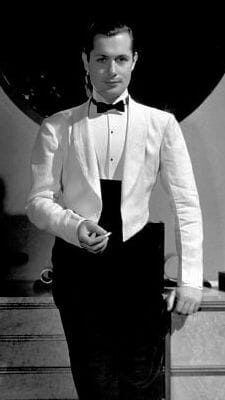
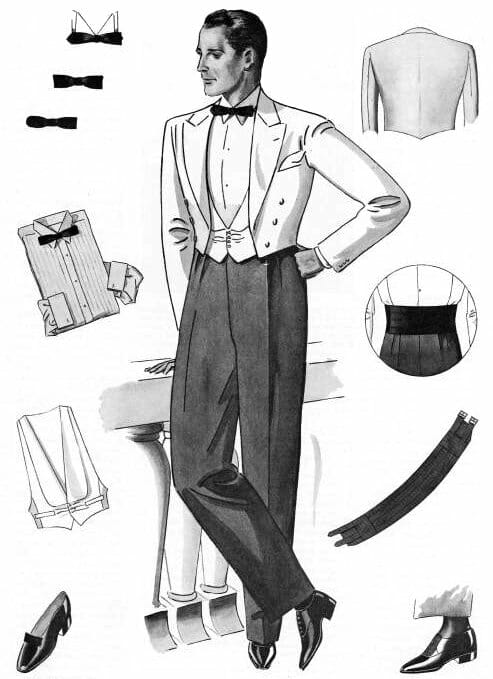
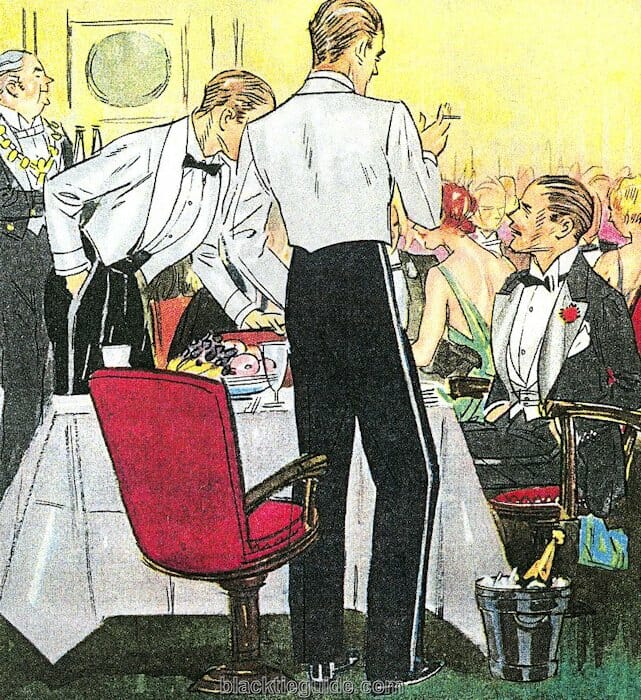
Then, as quickly as it had shot to fame, the mess jacket plunged from favor. In 1934 Apparel Arts noted that the garment was a victim of its own popularity having become a uniform for bell-hops and orchestra members. Additionally, to look its best it required the wearer to possess “the figure of an Adonis”, a trait not common to many men. The following year the magazine reported that the jacket was “now completely out of fashion” while Esquire advised its own readers to “forget about them, unless you’re in the navy . . . or unless you’re a banjo player or a sax blower and wearing a mess jacket is part of your job.”
Although the mess jacket’s time in the sun had come to an end, its impact on summer formal attire would be permanent. It had broken the mold and condequently set the stage for other novel innovations.
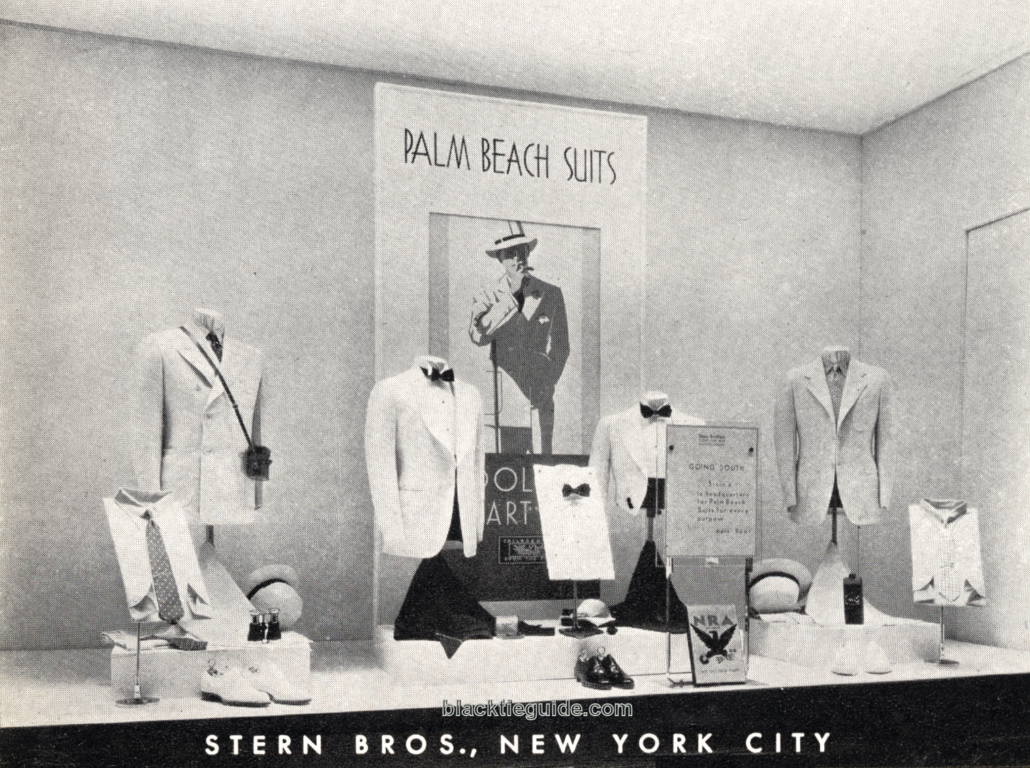
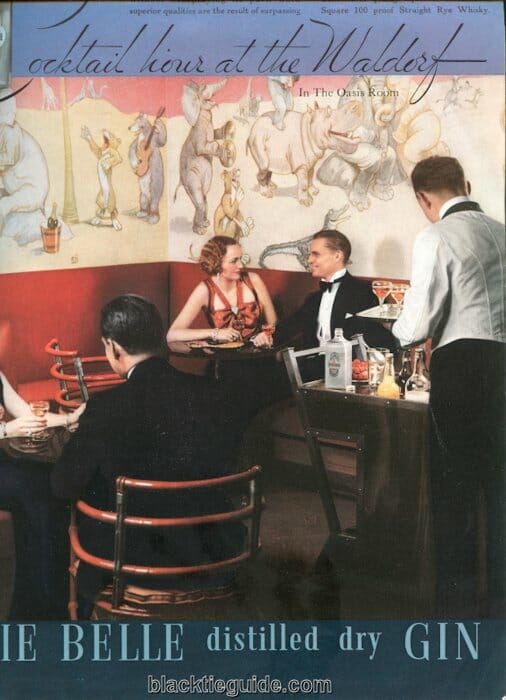
The White Dinner Jacket: A Perennial Favorite in Warm Weather
Although early Edwardian tailors had tinkered with the idea of white dinner jackets for hot weather, the concept did not catch on until the same year as the white mess jacket first appeared. In October 1931 Men’s Wear reported on a white shawl-collar dinner jacket with black trousers worn to an upscale Long Island black-and-white costume ball and stated that “these white evening jackets are growing in popularity among wealthy men at summer resorts.” The same issue also illustrated single- and double-breasted peak lapel versions of the jacket as seen at Cannes. Both were made of cream or white tropical worsted.
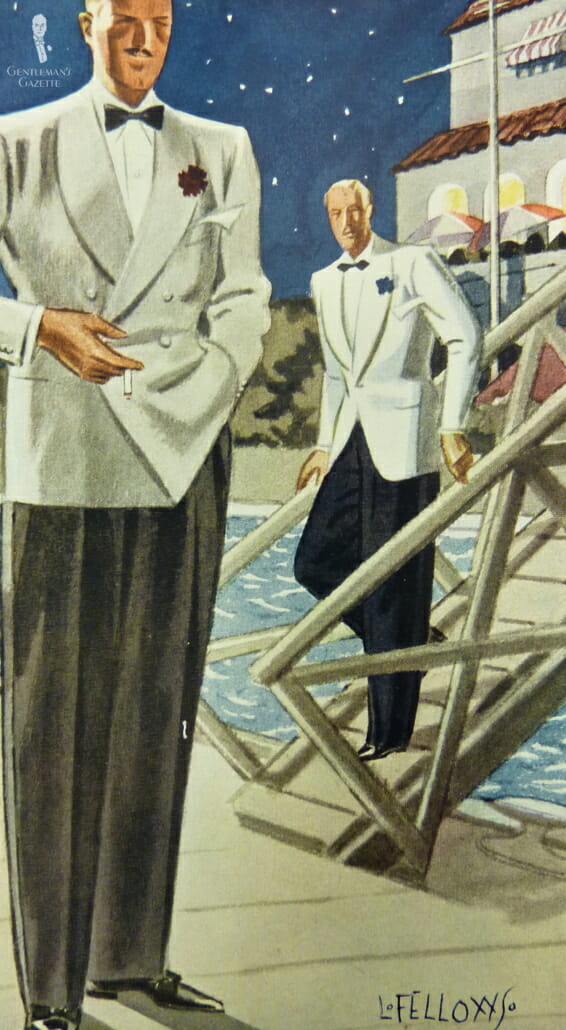
The white coat then migrated from the New York summer resort towns of Newport and Southampton to the winter resorts of Palm Beach and other southern colonies. In the summer of 1933 Men’s Wear reported that “Though not as well established as the mess jacket, it is rapidly gaining acceptance.” By this time it was typically made of white linen or Palm Beach material with self-faced lapels and the single-breasted shawl collar model was the most popular style. The accompanying shirts and waist coverings were same as for mess jackets of the time (soft pleated-bosom shirt with turndown collar, black silk cummerbund) while bow ties and shoes were as per standard black tie. Trousers were usually black or midnight blue in tropical weight worsted although they were also acceptable in the same white material as the jacket up until 1934. More trendy options included silk shirts or monk-front dress shoes, the latter favored by Englishmen in the West Indies.
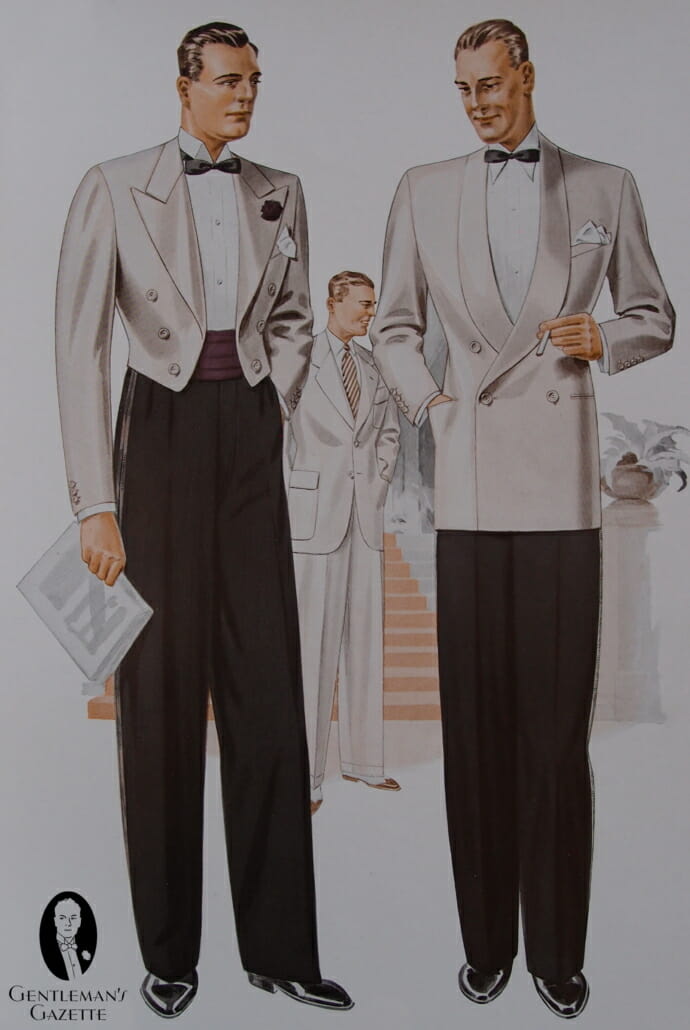
With the decline of the mess jacket’s popularity in 1934 the white and double-breasted jackets were the style of choice for comfortable evenings aboard ship, at summer dances in the country, and winter retreats in the tropics. For town, black or midnight-blue single-breasted jackets remained de rigueur, regardless of the season.
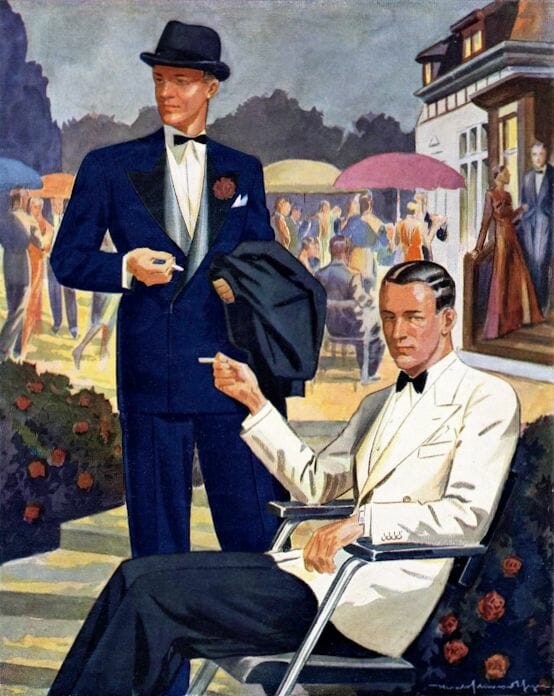
Colored Jackets & Accessories: Vibrant Hues in Hot Climates
Color exploded into warm-weather formal wear around 1933 mirroring a consecutive trend in summer attire in general. Said Apparel Arts in the summer of that year:
It is only in the last century that man has relinquished to woman the right to colorful attire. The new emphasis upon the fashionable importance of summer clothes is beginning, at last, to break up this traditional drabness and now, for the first time in almost a century, men of taste are showing a willingness to accept brilliant color and vivid pattern.
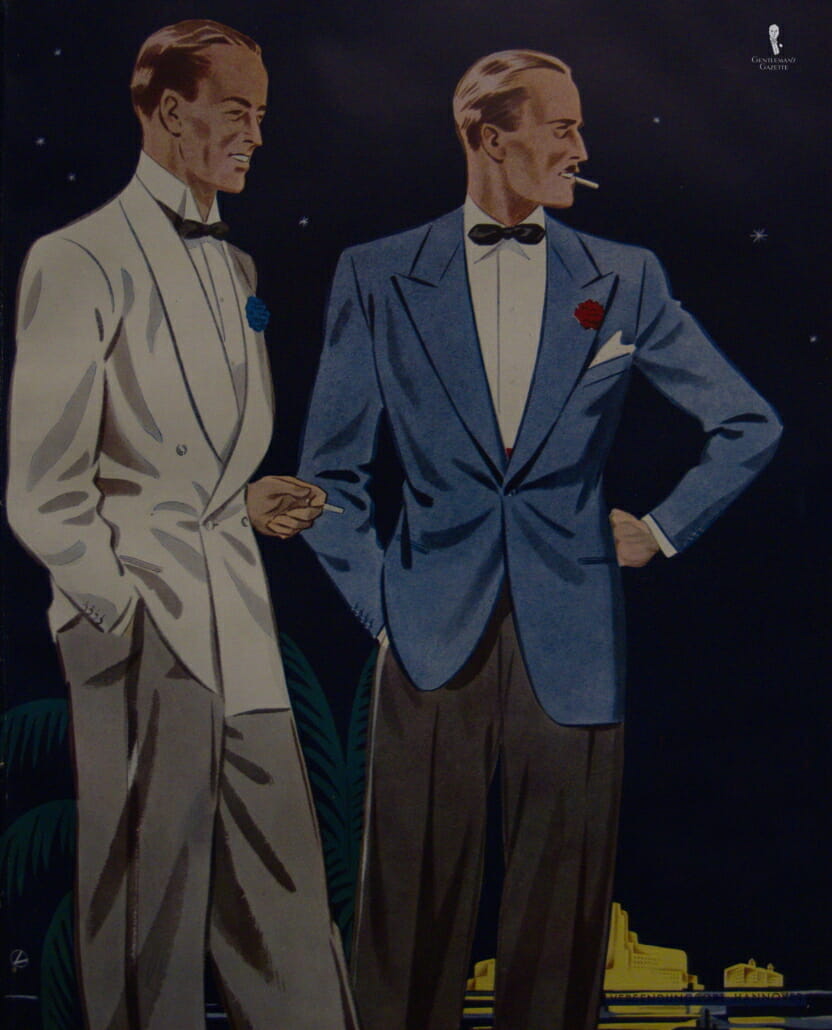
Dark red was the first color to be employed and its original canvases were the cummerbund, carnation boutonniere, and hosiery (either just the clocks or the entire sock). Eventually the color also appeared in the form of maroon, wine, and crimson silk waistcoats (a trend imported from “the exclusive London clubs”), dress jewelry, pocket squares, and straw hat bands. This made warm-weather attire distinctly more colorful than its conservative year-round cousin that typically featured only red boutonnieres and sometimes waistcoats.
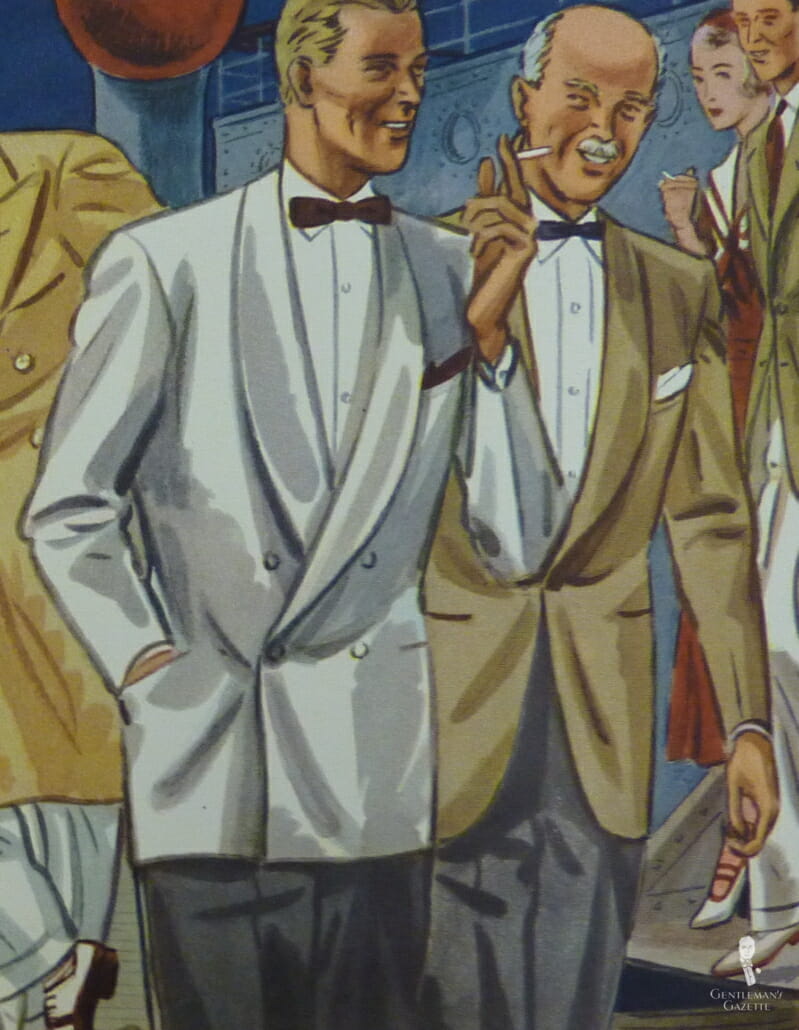
Blue was the second most popular color of the period, appearing in the same accessories including cornflower boutonnieres. Dark green was a distant third.
In 1935 summer evening color cautiously graduated from the dinner jacket’s accessories to the jacket itself in a tan hue called “Burma”. Along with occasional appearances of an equally understated grey tone or off-white silks, this remained the primarily alternative to white throughout the 1930s and ‘40s.
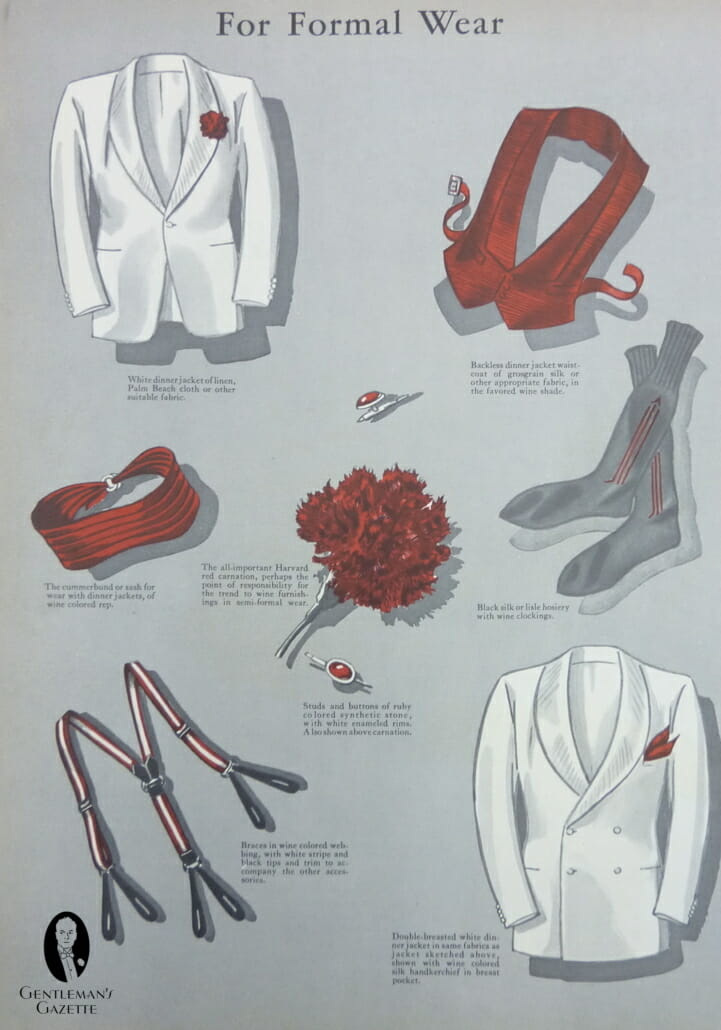
Depression-era flair in menswear was scaled back after World War Two and colored evening accessories became almost exclusively limited to red and midnight blue. Notably though, the list of accessories expanded to include the bow tie. Although limited to the white dinner jacket, this unorthodox trend was a harbinger of a much greater challenge to evening wear’s traditional black-and-white palette. The arrival of the pastel blue summer jacket in the late 1940s signaled the beginning of an explosion of color and pattern in formal wear that would last for the next thirty years.

Outerwear in Warm Weather
Stiff straw hats were considered acceptable with summer formal wear since the First World War. These were known variously as sennit, sailor and boater hats and would typically have a plain black band or a two-toned club band. In the late 1930s, coconut straw hats (aka cocoanut or coconut palm hats) also became allowable as did Panama hats in the late 1940s.
On cool summer evenings, the correct coat of choice was a camel hair polo coat.


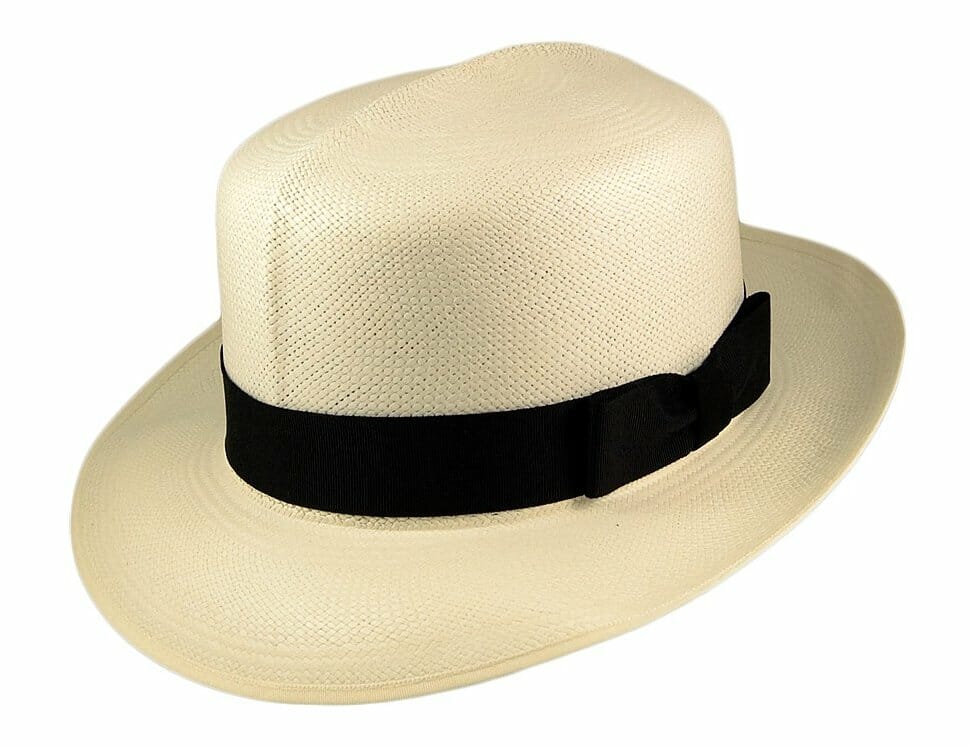
Formal Facts
Formal Facts: Warm-Weather White Tie
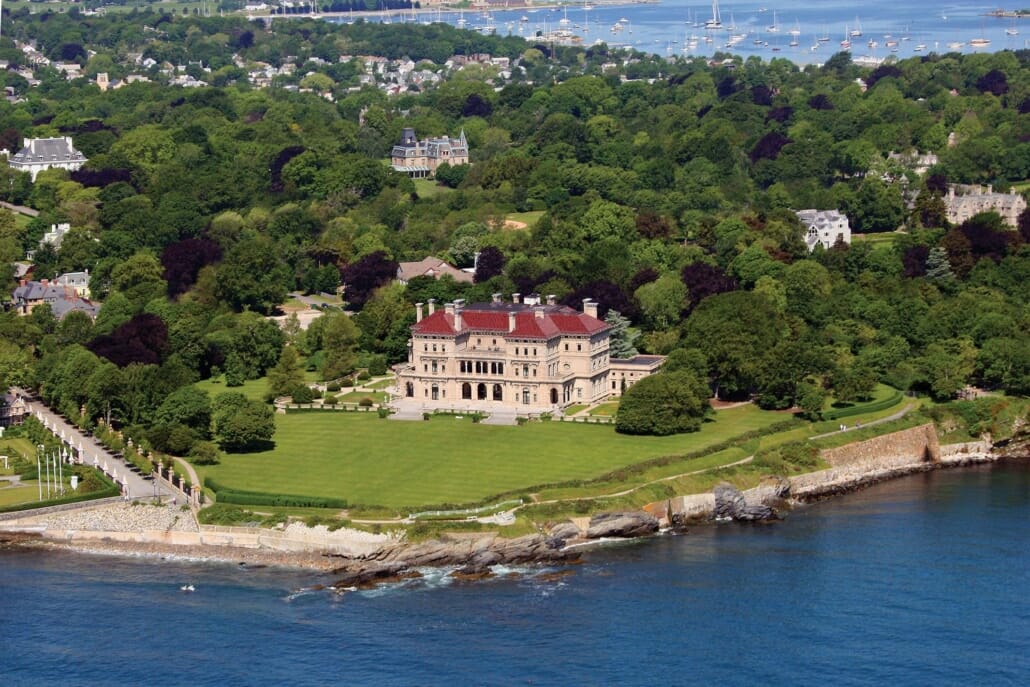
In 1922, Emily Post advised that there was no occasion for fashionable New Yorkers to wear full dress in summer “because no opera, formal dinners or balls are given between May and November since even the ultra-formal Newport resort gave up the practice in recent years.” A 1931 Men’s Wear article reaffirmed this saying that “The tailcoat is essentially a winter, spring and fall garment.” However, it noted that summer evening weddings were an exception to the rule: “As along as a wedding is formal and held in the evening, then the tailcoat is the thing to wear.”
Explore this chapter: 8 Vintage Evening Wear
- 8.1 Vintage Black Tie Etiquette & Dress Codes
- 8.2 Vintage Tailcoats & Tuxedos
- 8.3 Vintage Evening Waistcoats & Cummerbunds
- 8.4 Vintage Evening Shirts
- 8.5 Vintage Evening Neckwear
- 8.6 Vintage Evening Footwear
- 8.7 Vintage Evening Accessories
- 8.8 Vintage Evening Outerwear
- 8.9 Vintage Warm-Weather Evening Wear
- 8.10 Vintage Evening Weddings
- 8.11 Retro Evening Wear
